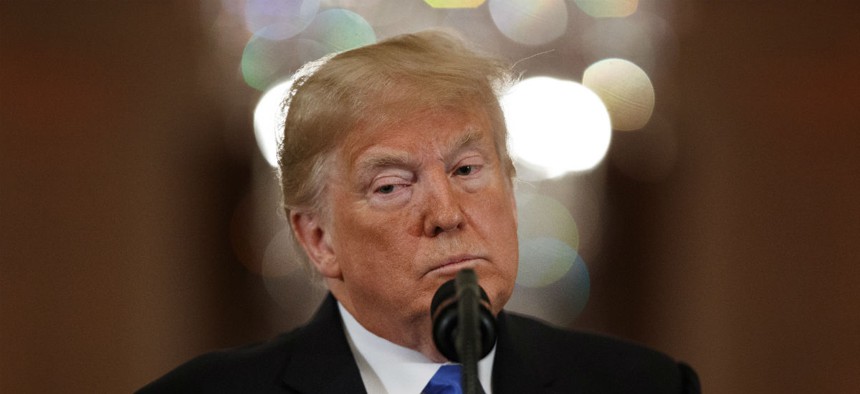
President Trump listens during a news conference at the White House on Nov. 7. Evan Vucci/AP
With Midterms Over, Lame-Duck Congress Now Turns to Avoiding a Shutdown
Some agencies are fully funded, but 300,000 feds still at risk of furloughs.
Leaders in Congress and the White House appeared at odds over government funding for the remainder of fiscal 2019, once again raising the possibility of a shutdown for many agencies across government.
President Trump used his first public appearance after Republicans lost control of the House in the midterm elections on Tuesday to reinforce his call for funding to build a wall along the U.S.-Mexico border, threatening to let appropriations lapse if Congress declines to approve the spending. Some agencies would be unaffected by a shutdown because they've already received appropriations through September 2019. But many others are currently operating under a continuing resolution set to expire Dec. 7.
The departments of Defense, Labor, Health and Human Services, Education, Energy, and Veterans Affairs received full-year funding through two "minibus" appropriations bills Trump has already signed into law. Others, such as the departments of Transportation, Housing and Urban Development, State, Interior, Agriculture, Treasury, Commerce, Homeland Security and Justice, are currently operating under the stopgap measure. More than 300,000 federal workers would face furloughs in a December shutdown, according to the affected agencies’ most recent shutdown plans.
Asked on Wednesday if the midterm results had impacted his demand that Congress fund the border wall and whether he would rule out the possibility of a shutdown next month, Trump said, "I can't commit to that, but it's possible.” He added that he was “not necessarily” committed to pursuing a shutdown strategy, but reiterated, “We need money to build the wall, the whole wall, not pieces of it.”
Trump will be working with a divided Congress come January, with Republicans maintaining control of the Senate. The president’s party will continue to control both chambers through the current spending battle, however. Senate Majority Leader Mitch McConnell said on Wednesday all sides will have to “work together” to avoid an appropriations lapse.
“We need to work this out,” McConnell said. “We’re going to do the best we can to try to achieve the president’s priorities, and hopefully we will not be headed down that path.”
Congress faced an easier road to passing spending bills after Trump earlier this year signed a two-year budget deal dramatically increasing spending caps for fiscal years 2018 and 2019. The funding measures already signed into law for fiscal 2019 account for 75 percent of annual discretionary spending, the most appropriations allocated on time in 22 years. Lawmakers have not yet raised spending caps instituted under the 2011 Budget Control Act for fiscal 2020, setting up another potential fight for the divided 116th Congress.
Congressional negotiators are now in conference over a third minibus bill that includes funding for Agriculture, Interior, Treasury, Transportation and HUD, as well as the Office of Personnel Management and General Services Administration.
That third minibus would provide the vehicle for a pay raise for the federal workforce, if lawmakers choose to provide one. The Senate version included a 1.9 percent raise for 2019, but the House remained silent on the issue, effectively supporting President Trump's pay freeze proposal. The second minibus that Trump earlier signed into law budgeted for the 1.9 percent increase, but final authorization would still have to come from the third minibus. Lawmakers appear to have reached an agreement to include the 1.9 percent raise, but Democrats say some fine points are still under negotiation.







